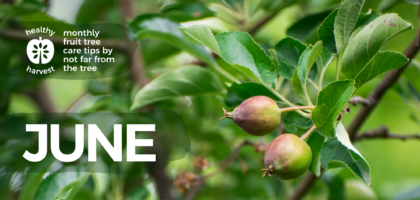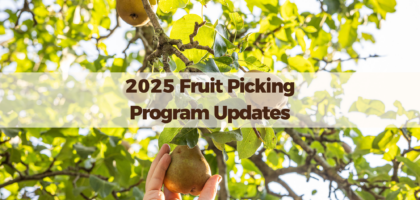
June Healthy Harvest Habits
Last month, Not Far From The Tree and Susan Poizner of Orchard People hosted a two-part
pruning workshop. On a 2.5-hour Wednesday evening zoom call, Susan (a true fruit tree expert) taught
us the basics of winter and summer pruning – how to set up a young tree for success by intense early
pruning, how to decide on and create an optimal fruit-bearing shape, and how to maintain an older tree.
Attendees ranged from those who had a fruit tree they were unsure of how to care for in their back yard
to those of us who just love fruit and want to learn more.
Saturday morning found us under a beautiful sky in the Spadina Museum orchard, which is full
of apple trees in need of a good pruning. We started off at a young tree, only a couple years old, in dire
need of some reshaping.
This tree was part of Lesson 1: Set your young trees up for success. Susan suggests shaping a
young tree (or “whip”, a piece of bare-root nursery stock) into a triangle around a central leader. In this
kind of shape, you can keep 4 or fewer “platforms” around the main trunk, each one with 3-5 main
branches spread around the trunk. This kind of shape helps sun and air reach each branch as equally as
possible, so that each branch can produce a bounty of fruit.
However, this young tree had been growing a bit wild for the first years of its life and there was
no clear central leader. Instead, Susan proposed a “vase” shape, with several main branches splitting up
and out from the main trunk. One by one, volunteers stepped forward to make a snip with hand pruners
(always at an angle to avoid water pooling on the wound), and the vase took shape.
We moved onto the next tree, an older apple with some congestion issues in its dense upper
branches. This tree taught Lesson 2 (it’s never too late to help your tree out a little bit) and Lesson 3
(give a tree room to breathe). Although its overall shape was relatively set by this point in life, we
identified places with overlapping branches that could be removed to open up leaves to the sun and
increase air circulation. A rule of thumb for how much air circulation is enough to prevent disease from
spreading: be able to visualize throwing a cat (or pig, or small cow) through the canopy without causing
too much harm to animal or tree. Since this was a summer pruning, we stuck closely to the 25% rule –
never take more than 25% of a tree’s canopy in a single prune, especially on an older tree.
As we moved through the orchard with teams splitting off to address the problem we’d found, I
got to work with another volunteer on another large tree. At this tree, Susan found some “mummy
fruits” – dead apples from the last season which had rotted on the tree. We bagged these up carefully to
keep them out of the compost and stop them from spreading any disease or rot to the rest of the tree.
This is Lesson 4: Protect your tree from disease! Clean your tools with rubbing alcohol before and after
pruning, and in between moving from tree to tree. Always remove any dead or diseased branches, and
dispose of those diseased branches and fruit separately to stop them from spreading anything.
Although we’d each split off to work separately on trees, the orchard was full of participants
running back and forth between trees to check on each other’s progress and ask for second opinions on
cuts they were about to make. This is Lesson 5: Phone a friend (or an expert like Susan) if you’re not
sure what to do. Pruning a tree can be intimidating especially when the tree seems healthy, but pruning
is necessary to keep fruit trees healthy and bearing bountiful fruit. And there are plenty of resources out
there to help – Susan’s Orchard People website has a free ebook and podcast as well as extensive online courses and books to answer any question you can think of about fruit tree care. Fruit trees create a
beautiful bounty out of sun, water, and soil for us to share – why not give them as much help as we can?
Interested in purchasing pruning equipment? Be sure to check out our equipment sponsor, GARDENA!

June Healthy Harvest Habits

2025 Fruit Picking Program Updates